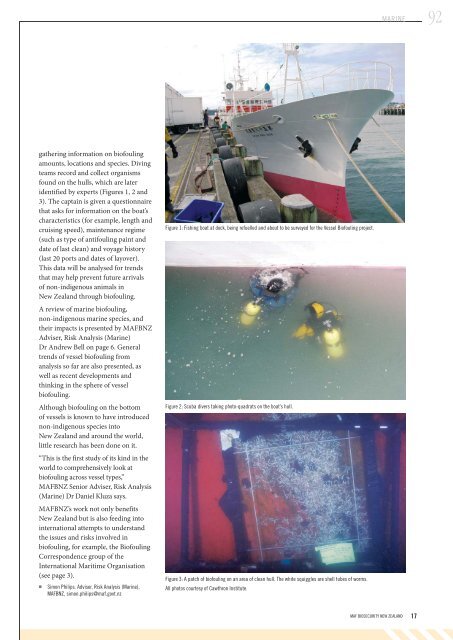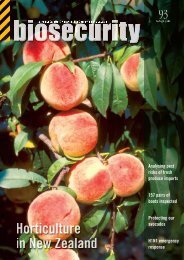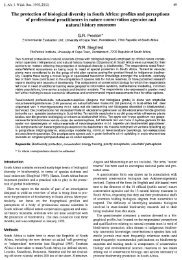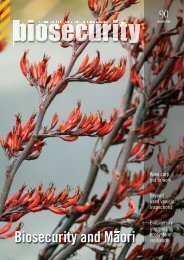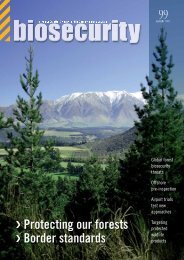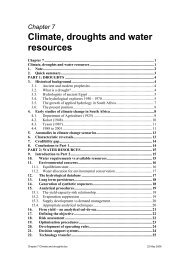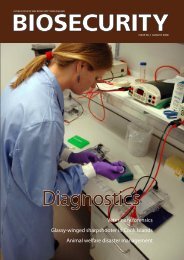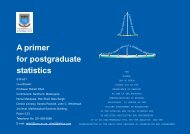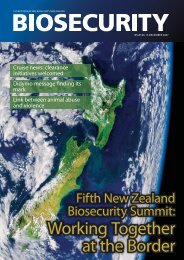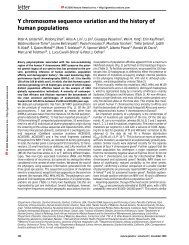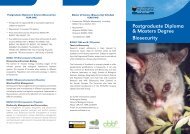Biosecurity magazine - Biosecurity New Zealand
Biosecurity magazine - Biosecurity New Zealand
Biosecurity magazine - Biosecurity New Zealand
You also want an ePaper? Increase the reach of your titles
YUMPU automatically turns print PDFs into web optimized ePapers that Google loves.
MARINE<br />
92<br />
gathering information on biofouling<br />
amounts, locations and species. Diving<br />
teams record and collect organisms<br />
found on the hulls, which are later<br />
identified by experts (Figures 1, 2 and<br />
3). The captain is given a questionnaire<br />
that asks for information on the boat’s<br />
characteristics (for example, length and<br />
cruising speed), maintenance regime<br />
(such as type of antifouling paint and<br />
date of last clean) and voyage history<br />
(last 20 ports and dates of layover).<br />
This data will be analysed for trends<br />
that may help prevent future arrivals<br />
of non-indigenous animals in<br />
<strong>New</strong> <strong>Zealand</strong> through biofouling.<br />
A review of marine biofouling,<br />
non-indigenous marine species, and<br />
their impacts is presented by MAFBNZ<br />
Adviser, Risk Analysis (Marine)<br />
Dr Andrew Bell on page 6. General<br />
trends of vessel biofouling from<br />
analysis so far are also presented, as<br />
well as recent developments and<br />
thinking in the sphere of vessel<br />
biofouling.<br />
Although biofouling on the bottom<br />
of vessels is known to have introduced<br />
non-indigenous species into<br />
<strong>New</strong> <strong>Zealand</strong> and around the world,<br />
little research has been done on it.<br />
“This is the first study of its kind in the<br />
world to comprehensively look at<br />
biofouling across vessel types,”<br />
MAFBNZ Senior Adviser, Risk Analysis<br />
(Marine) Dr Daniel Kluza says.<br />
MAFBNZ’s work not only benefits<br />
<strong>New</strong> <strong>Zealand</strong> but is also feeding into<br />
international attempts to understand<br />
the issues and risks involved in<br />
biofouling, for example, the Biofouling<br />
Correspondence group of the<br />
International Maritime Organisation<br />
(see page 3).<br />
■<br />
Simon Philips. Adviser, Risk Analysis (Marine),<br />
MAFBNZ, simon.philips@maf.govt.nz<br />
Figure 1: Fishing boat at dock, being refuelled and about to be surveyed for the Vessel Biofouling project.<br />
Figure 2: Scuba divers taking photo-quadrats on the boat’s hull.<br />
Figure 3: A patch of biofouling on an area of clean hull. The white squiggles are shell tubes of worms.<br />
All photos courtesy of Cawthron Institute.<br />
MAF BIOSECURITY NEW ZEALAND 17


